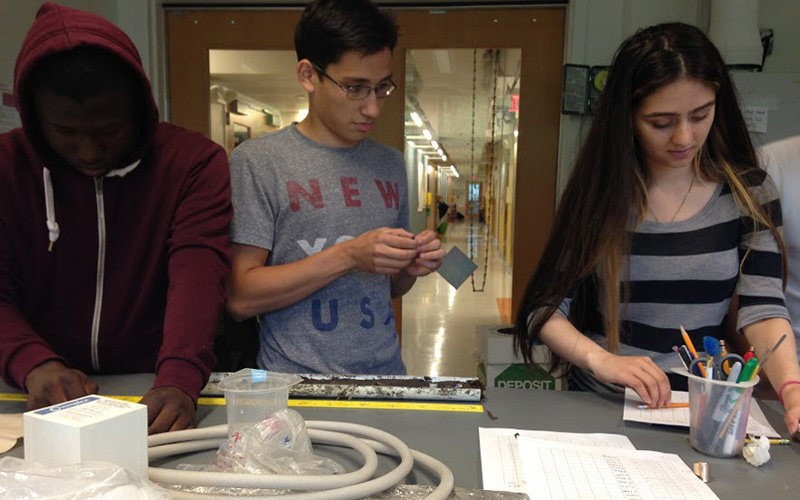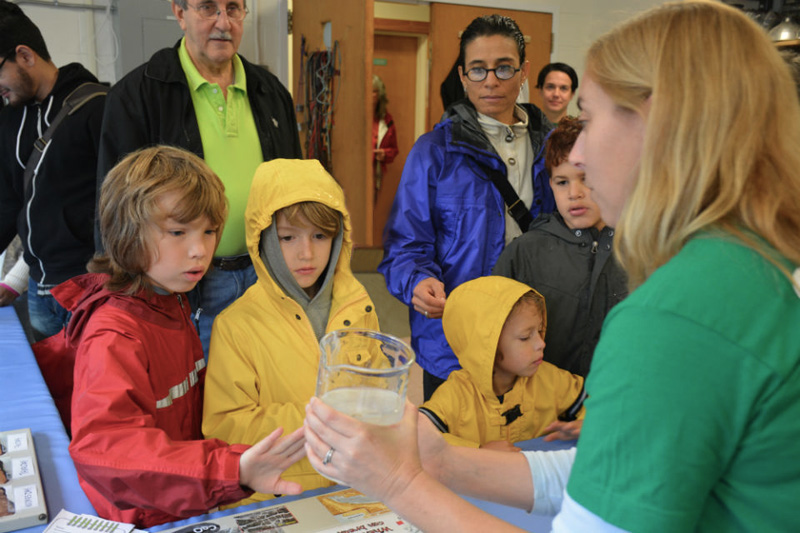Education
A vigorous set of education and outreach programs complements our research agendas.
Lamont-Doherty Earth Observatory offers students and educators access to world‐class research laboratories with a wide range of educational programming. Lamont has over 300 scientists, engineers, Ph.D. candidates, and postdoctoral fellows studying Earth and its processes. Our public events calendar offers seminars and lectures with the opportunity to network with researchers. In addition to hosting many school groups throughout the academic year, Lamont currently runs five prominent education programs for K-16 students and educators, and we are continuing to develop new engagement opportunities for learners of all ages through our Education and Outreach Office.
Field Trips
Over the past year, Lamont-Doherty formalized a field trip program to the Observatory, providing opportunities for students of all ages to interact with science and scientists on campus. We offer tailored lab visits and activities for groups to explore our ocean sediment core repository, seismic sounds, polar and tree ring research, and much more. Fifteen groups visited campus from New York and New Jersey during the year.
Research Opportunities for High School Students

High school students work on a core sample as part of the Secondary School Field Research Program. (John Bjornton)
Many of our education and outreach efforts have focused on creating research opportunities on the Lamont campus for high school students. Our Summer Intern Program and Secondary School Field Research Program partner students with scientist mentors to conduct research on campus over several weeks and prepare to formally present their findings. In the summer of 2015, 26 undergraduate students worked on a variety of projects across Lamont’s divisions as part of the intern program, and the secondary school program brought 45 students and nine teachers to campus for a six-week program focused on environmental and wetlands chemistry.
We are building on the success of these programs to bring additional students to campus during the school year to participate in internships and work on research projects under the mentorship of our world-renowned scientists.
A new program for high school students will emphasize learning science by doing science. Students will read peer-reviewed literature, participate in discussions on scientific papers, receive advice from Columbia University students about the transition to college, and have ample opportunity to practice their presentation skills. The main focus of their time at Lamont will be in hands-on work on their research projects. Putting students in the role of active participants in their own learning builds critical thinking and problem-solving skills, independence, and confidence, and provides students with a glimpse of life as a research scientist. Lamont has initiated a program with the Lycée Français de New York and is in discussions with other schools to provide similar programs. More broadly, we hope that this kind of experience introduces students to important concepts in Earth science to pique their interest in STEM subjects and engage potential future scientists through participatory research and an outstanding academic experience.
Community Science
The Observatory also shares its innovative research in Earth and environmental sciences through outreach events in New York and New Jersey. In fiscal year 2015, the Observatory participated in Kids Week at the Intrepid, Sun and Earth Day at the American Museum of Natural History, the Great Fish Count, and the World Science Festival. In total, these events attracted over 4,000 people. The Observatory also hopes to develop more on-campus events, including a career day in Earth science and sustainability in late spring, where local students can visit campus to learn more about careers in the STEM fields and hear firsthand from Lamont scientists, postdocs, and graduate students about their own paths from high school to successful science careers.
Lamont Open House

In the Rock Mechanics Lab, Heather Savage helps young Open House visitors explore some of the properties of rocks. (Kim Martineau)
The Observatory has a long history of public education through its biennial Open House, featuring free lectures, demonstrations and hands-on workshops that share important research findings beyond the academic community. Audiences of all ages are introduced to concepts in Earth Science and have an opportunity to explore the interdisciplinary projects that the Observatory’s scientists are engaged in. The one-day event draws over 3,000 visitors to campus.
Department of Earth and Environmental Sciences
Much of our formal education is taught through the Department of Earth and Environmental Sciences (DEES), which has been named by the National Research Council as the best Earth science Ph.D. program in the country, a ranking that reflects Lamont’s exceptional people, resources and affiliated programs. The students in DEES bring enthusiasm and innovative ideas, lend fresh energy to our investigations and help inspire future research.
In Fall 2015, DEES welcomed 18 new graduate students from five different countries. Many of our new and continuing graduate students were recipients of prestigious fellowships this past year. Among them:
- Six were recipients of National Science Foundation Graduate Research Fellowships: Ruth Oliver, Elizabeth Shoenfelt, Olivia Clifton, Frank Pavia, Rachel Marzen and Joshua Russell. This fellowship program recognizes and supports outstanding graduate students who are pursuing research-based degrees. Fellows benefit from a three-year stipend, along with an education allowance for tuition and fees and opportunities for international research and professional development.
- Three graduate students, Wingyin Chu, Xiaoqiong Li and Jan-Erik Tesdal, received NASA Earth and Space Science Fellowships. The purpose of the NESSF fellowship is to ensure continued training in disciplines that contribute to NASA’s scientific goals.
- Genevieve Coffey received a Fullbright Fellowship, an award that enables graduate students, young professionals and artists from abroad to conduct research and study in the United States.
- Asmi Napitu received the Schlumberger Foundation Faculty for the Future fellowship, which is given to women from developing and emerging economies to pursue Ph.D. or post-doctorate studies in science, technology, engineering, and mathematics disciplines at leading universities worldwide.
- Daniel Sousa received a National Defense Science and Engineering Graduate Fellowship, awarded to applicants who will pursue a doctoral degree in, or closely related to, an area of interest to the Department of Defense.
Join Us Online
You can keep up with Lamont’s latest news on our website and join us on Twitter, Facebook and LinkedIn.
Please sign up for our e-newsletter if you’d like to receive monthly updates on our research and educational activities.